Week 9 - Day 1 (Ch 11 - Pt 1 Pyschological Disorders)
Announcements
-
Mental health services
-
RAs
-
Hotline: 1-800-273-8255
-
Counseling center: 205-348-3863
-
UAPD: 205-348-5454
How are psychological disorders classified?
-
People have long struggled with how best to understand psychopathology (mental disorder)
-
Earliest views of psychopathology explained apparent “madness” as resulting from possession by demons or evil spirits
-
During the last 200 years, recognition has grown that psychopathology reflects dysfunction of the body, particularly of the brain
Psychopathology is different from everyday problems
-
Psychological disorders are common and account for the greatest proportion of disability in developed countries (Centers for Disease Control and Prevention, 2011)
-
Drawing the line between a normal emotional experience and a mental disorder can be difficult
-
When a psychological problem disrupts a person’s life and causes significant distress over a long period, the problem is considered a disorder rather than the normal low points of everyday life
Pathology
-
In determining whether behavior represents psychopathology, it is important to consider certain criteria:
-
Does the person act in a way that deviates from cultural norms for acceptable behavior?
-
Is the behavior maladaptive?
-
Is the behavior self-destructive?
-
Does the behavior cause discomfort and concern to others, thus impairing a person’s social relationships?
Categories of Psychological Disorders
-
1800s: Psychiatrist Emil Kraepelin identified mental disorders on the basis of groups of symptoms that occur together
-
In 1952, the American Psychiatric Association published the first edition of the Diagnostic and Statistical Manual of Mental Disorders (DSM)
-
Disorders are described in terms of observable symptoms
-
Patients must meet specific criteria to receive a particular diagnosis
-
Multiaxial system: assessment along five axes that describe important mental health factors
-
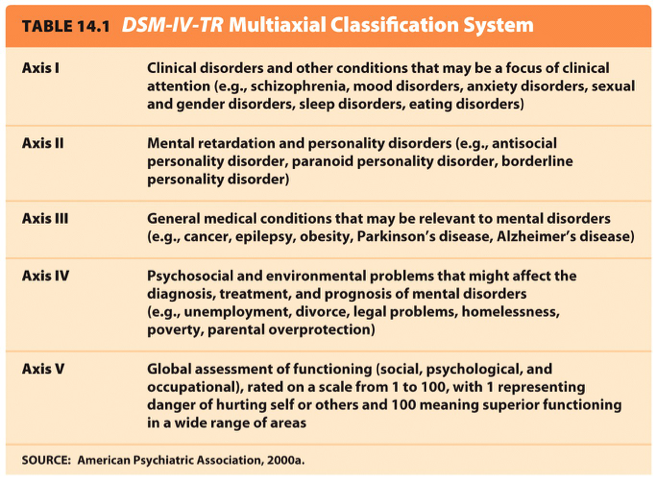
-
Categorical versus dimensional approach
Comorbidity
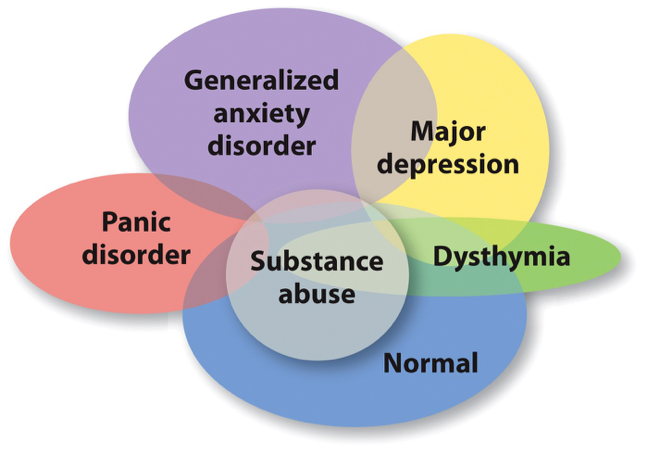
Psychological disorders have many causes
-
Biological and environmental factors are thought to play important developmental roles in psychopathology
-
Diathesis-stress model: a diagnostic model that proposes that a disorder may develop when an underlying vulnerability is coupled with a precipitating event
-
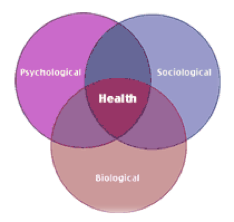
-
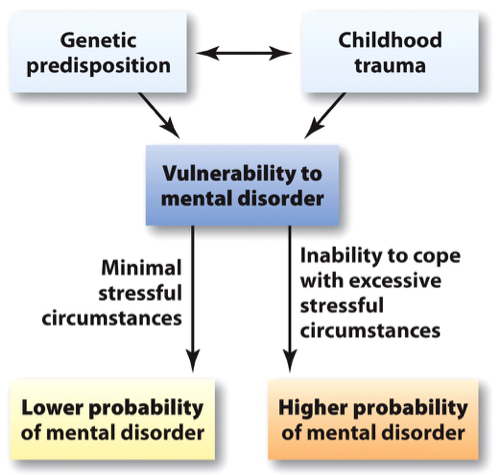
Biological factors
-
The biological perspective focuses on how physiological factors contribute to psychological disorders:
-
Genetics
-
Prenatal problems (e.g., malnutrition, exposure to toxins, maternal illness)
-
During childhood and adolescence, environmental toxins and malnutrition can put an individual at risk for mental disorders
-
Biological factors may contribute to mental disorders because of their effects on the central nervous system
-
Functional neuroimaging is currently at the forefront of research into the neurological components of mental disorders
-
PET and fMRI have revealed brain regions that may function differently in individuals with mental disorders
Psychological factors
-
Psychological factors play an important role in the expression and treatment of mental disorders
-
Family systems model: An individual’s behavior must be considered within a social context, particularly within the family
-
Problems that arise within an individual are manifestations of problems within the family
-
Sociocultural model: Psychopathology is the result of the interaction between individuals and their cultures
-
Differences in occurrence of disorders are due to differences in lifestyles, in expectations, and in opportunities between classes
Cognitive-behaviroal factors
-
The central principle of the cognitive-behavioral approach is that abnormal behavior is learned
-
Proponents of strict behaviorism argue that mental disorders result from classical and operant conditioning
-
According to the revised cognitive-behavioral perspective, thoughts and beliefs are types of behavior and can be studied empirically
-
The premise of this approach is that thoughts can become distorted and produce maladaptive behaviors and maladaptive emotions
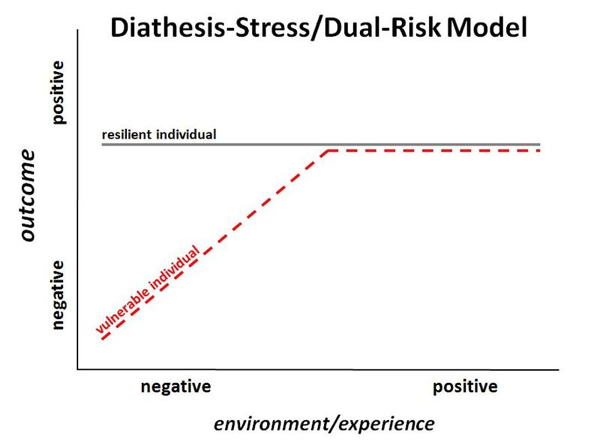

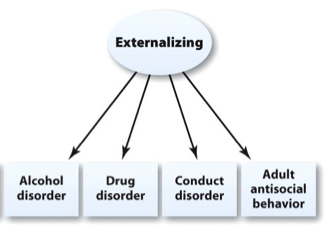
Anxiety disorders
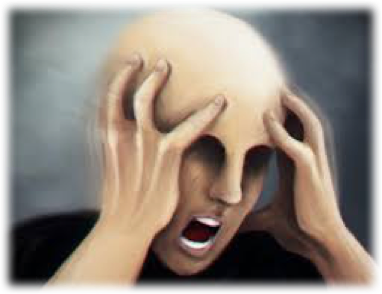
Can anxiety be the root of seemingly different disorders?
-
Anxiety itself is normal and even useful
-
It can prepare us for upcoming events and motivate us to learn new ways of coping with life’s challenges
-
Anxiety can become debilitating and can interfere with every aspect of life
-
Anxiety disorders are characterized by excessive anxiety in the absence of true danger
Different types of anxiety disorders
-
More than 1 in 4 Americans will have some type of anxiety disorder during their lifetimes
-
Different anxiety disorders share some emotional, cognitive, somatic, and motor symptoms, even though the behavioral manifestations of these disorders are quite different
-
Because chronic stress can damage the body, including the brain, it is very important to identify and effectively treat disorders that involve chronic anxiety
Phobic disorders
-
A phobia is a fear of a specific object or situation
-
Specific phobias affect about 1 in 8 people and involve particular objects and situations
-
Blood-injection-injury type
-
Animals
-
Elements of physical environment
-
Disasters
-
Social phobia is a fear of being negatively evaluated by others
-
Includes fears of public speaking, speaking up in class, meeting new people, and eating in front of others
-
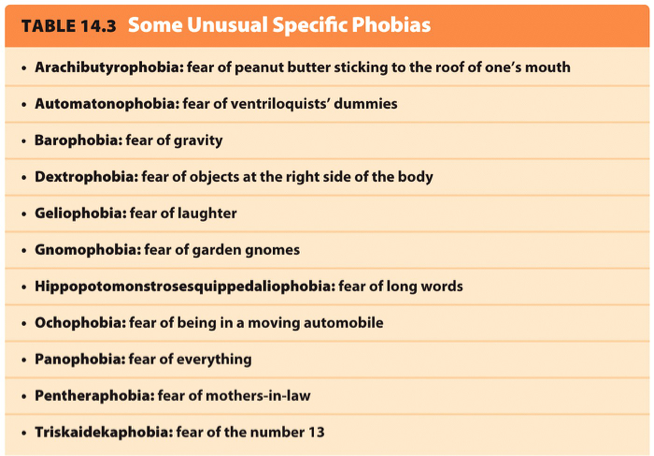
| psychopathology | Study of mental disorders |
| Multiaxial system | System which asseses mental health factors along five axes |
| Axis 1 | Part of multiaxial system. Clinical disorders and other conditions that may be a focus of clinical attention (schizophrenia, mood disorders, etc) |
|
Axis 2 |
Part of multiaxial system. Mental retardation and personality disorders. |
| Axis 3 | Part of multiaxial system. General medical conditions that may be relevant to mental disorders (cancer, obesity, etc) |
|
Axis 4 |
Part of multiaxial system. Psychological and environmental problems that might affect the diagnosis, treatment, and prognosis of mental disorders (unemployment, divorce, legal problems, etc) |
|
Axis 5 |
Part of multiaxial system. Global assessment of functioning (social and occupational) rated from 1 to 100 (1 means danger of hurting self and others and 100 means superior functioning) |
|
comorbidity |
Having two or more chronic diseases (anxiety and depression for example) |
|
diasthesis-stress model |
A diagnostic model tht proposes that a disorder may be developed when underlying vulnerability is coupled with participating in an event |
| family systems model | Model which asserts that an individual's behavior must be described within a social context (specifically within the family) |
|
sociocultural model |
Model which asserts that psychopathology is the result of interaction between individuals and their cultures |
|
cognitive-behavioral approach |
Asserts that abnormal behavior is learned |
| phobia | Fear of a specific object or situation |
|
social phobia |
fear of being negatively evaluated by others |